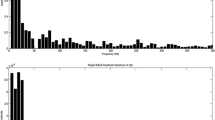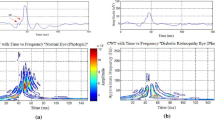Abstract
Studying the oscillatory potentials in diabetic retinopathy, the authors experienced several problems interpreting results of digital filtering. The main problem was the separation of the first potential from the a-wave, since their frequencies are within the same range. To improve the procedure of measuring implicit times and of calculating amplitudes, the filtering was started with a finite impulse response filter and followed by a fast Fourier transform. The power of the oscillatory potential was calculated by determining the dominant frequency in the Fourier transformed response and expressed in microwatts. A group of normal subjects was compared with a group of early diabetic retinopathy patients. It appears that even in pathological circumstances a quantitative expression of the oscillatory potential is possible.
Similar content being viewed by others
References
Algvere P (1968) Clinical studies on the oscillatory potentials of the human electroretinogram with special reference to the scotopic b-wave. Acta Ophthalmol 46: 993–1024.
Algvere P, Westbeck S (1972) Human ERG in response to double flashes of light during the course of dark adaption: a Fourier analysis of the oscillatory potentials. Vision Res 12: 195–214.
Algvere P, Wachtmeister L (1972) On the oscillatory potentials of the human electroretinogram in light and dark adaption. II. Effect of adaption to background light and subsequent recovery in the dark. A Fourier analysis. Acta Ophthalmol 50: 837–862.
Ewen King-Smith P, Loffing DH, Jones R (1986) Rod and cone ERGs and their oscillatory potentials. Invest Opthalmol Vis Sci 27: 270–273.
Frost-Larsen K, Larsen HW, Simonsen SE (1981) The value of dark adaptation as a prognostic tool in diabetic retinopathy. Metabol Pediatr Ophthalmol 5: 39–44.
Heynen HGM, van Norren D (1985) Origin of the electroretinogram in the intact macaque eye: II. Current source-density analysis. Vision Res 25: 709–715.
Miyake Y, Solish A (1978) Clinical application of a digital computer software system to electrodiagnosis. Ophthalmol Res 10: 268–278.
Rabiner R, Gold B (1975) Theory and application of digital signal processing. Englewood Cliffs, New Jersey, Prentice Hall.
Stodtmeister R (1973) The spectral sensitivity functions of human ERG wavelets. Ophthalmic Res 5: 21–30.
van Lith GHM, Meininger J, van Marie GW (1973) Electrophysiological equipment for total and local retinal stimulation. Doc Ophthalmol Proc Series 2: 213–218.
Wachtmeister L (1973) On the oscillatory potentials of the human electroretinogram in light and dark adaption. III. Thresholds and relation to stimulus intensity on adaption to background light. Acta Ophthalmol 51: 95–113.
Wachtmeister L, Dowling JE (1978) The oscillatory potentials of the mudpuppy retina. Invest Ophthalmol Vis Sci 17: 1176–1188.
Yonemura D, Tsuzuki K, Aoki T (1962) Clinical importance of the oscillatory potential in the human ERG. Acta Ophthalmol Suppl 70: 115–123.
Author information
Authors and Affiliations
Rights and permissions
About this article
Cite this article
Van Der Torren, K., Groeneweg, G. & Van Lith, G. Measuring oscillatory potentials: Fourier analysis. Doc Ophthalmol 69, 153–159 (1988). https://doi.org/10.1007/BF00153696
Issue Date:
DOI: https://doi.org/10.1007/BF00153696




